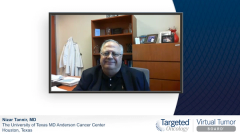
Adjuvant Therapy Treatment Approaches for Patients with Advanced Clear Cell RCC
Moshe Ornstein, MD, MA, discusses his approach to adjuvant therapy while treating patients with advanced clear cell RCC.
Episodes in this series

Nizar Tannir, MD: We’re going to finish our program with a discussion about the data from KEYNOTE-564, what it brings, and how we think about adjuvant therapy. Does 1 year of pembrolizumab for patients who qualified for that trial—pembrolizumab for 1 year over placebo—cure patients who wouldn’t have otherwise been cured if they didn’t receive adjuvant pembrolizumab for 1 year and wouldn’t have been salvaged with doublet or triplet later, when they recurred? Or are we merely delaying recurrence? This is a question I’m still grappling with. I have that discussion with patients. Obviously, they’re important data. There’s a trend toward OS [overall survival] with pembrolizumab over placebo from the Kaplan-Meier curves, but I’d like to get your thoughts on this, starting with Moshe. What do you think? How are you interpreting the data? What are you telling your patients?
Moshe Ornstein, MD, MA: It’s a great question. When it comes to adjuvant therapy in general, it’s a tricky business because you have patients who are cured with surgery alone—even if they didn’t get any therapy—and we’re overtreating them by giving them therapy. On the other side of the spectrum, you have patients who are still going to have a recurrence possibly around the same time and still have the same end point in terms of survival, even if they get adjuvant therapy. We’re looking for whether we can isolate those patients for whom there’s a tangible benefit not just in DFS [disease-free survival] but also in OS.
My approach since this has been approved is that for patients who are high risk and M1 NED [no evidence of disease], acknowledging the relatively small numbers, those patients should get or at least be strongly considered for adjuvant pembrolizumab. I’m giving it as a standard for those patients. Certainly, we’re hopeful that the OS benefit moves from being just a trend and translates into a significant benefit, although it’s going to take time for that to mature. This is an I/O [immuno-oncology] therapy, and systemic therapies have improved over time, which means that it’s more challenging to find end points for survival in an adjuvant setting in which many patients are already cured.
For patients who have intermediate-high risk—which didn’t make up most of the patients—I talk to them about the fact that those 2 ends of the spectrum exist. It’s important to take the patient’s perspective into consideration. A lot of patients think, “If I have a recurrence in 2 years and I die from the disease without taking an approved immunotherapy in the adjuvant setting, how am I going to feel about myself as a patient and about the oncology team?” That’s a real consideration, because we don’t know, and there’s a chance that the OS benefit pans out.
This is different from the S-TRAC study, where the curves were completely overlapping. The long-term benefits of immunotherapy can take time to mature. Even in the intermediate high-risk group, most patients have been electing to receive adjuvant pembrolizumab regardless of their risk. I’ve been giving it to most patients. I generally will give it unless a patient is concerned about the toxicities after we discuss them. I believe the label is very broad in terms of what they allow in the adjuvant setting. I don’t think it’s as specific as the inclusion criteria in KEYNOTE-564. I worry that there might be patients with [much] lower risk who might be given adjuvant therapy because of the temptation by a physician to do something and the temptation of a patient to receive something to feel like they’re doing something. But in general, for patients who would have met the inclusion criteria for this trial, I’m offering it as an option, and most patients elect to receive it.
Nizar Tannir, MD: To follow up on that question, I have 2 questions for you, Moshe. What therapy will you give that patient who accepts your recommendation to receive adjuvant therapy? If you give them pembrolizumab for 1 year and then they relapse, are you concerned that you’re compromising their response to subsequent immune checkpoint therapy?
Moshe Ornstein, MD, MA: The short answer is that we don’t know the answer. Over time, we’ll have follow-up data from KEYNOTE-564 about subsequent therapies. In terms of my practice, I haven’t seen a patient with explosive disease while on pembrolizumab in the adjuvant setting, but the decision in terms of what to do for subsequent treatment will depend on 2 main factors. One is the timing of recurrence: whether it’s immediate while they’re on therapy, soon after discontinuing therapy after a year, or 3 or 4 years down the road. Those patients would be treated differently. Also, some of this has to do with the nature of the recurrence. Are they recurring by way of a couple of small pulmonary nodules that have suddenly met criteria for PD [progressive disease]? Or are they recurring because they suddenly have lots of bone metastases or new liver metastases? I’d treat both of those differently. Frankly, I haven’t been faced with that a lot because it’s still relatively new, but the timing and the nature of progression will determine the subsequent therapies in my clinic.
Transcript edited for clarity.










































